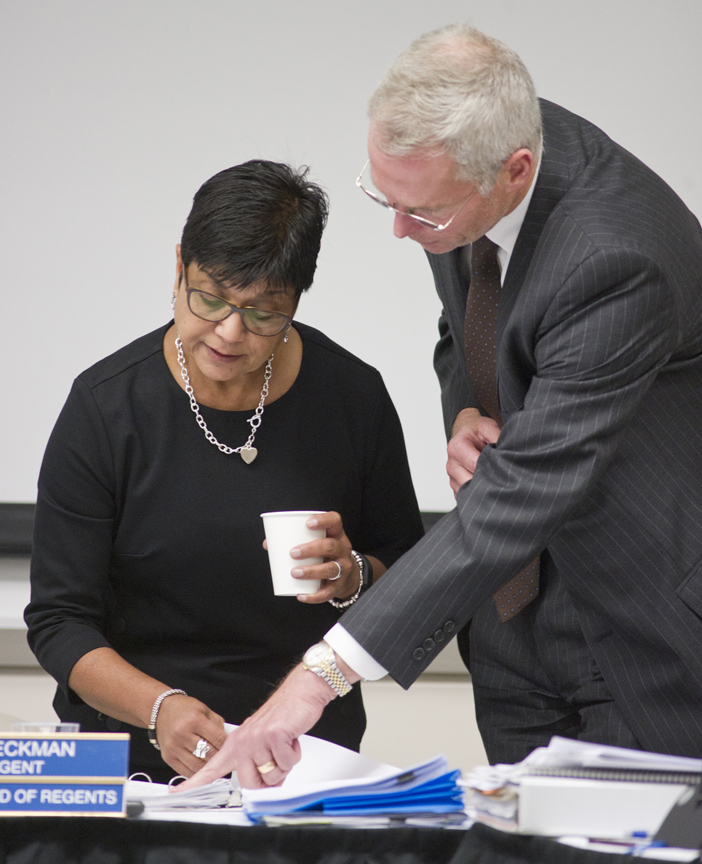FAIRBANKS — The University of Alaska Board of Regents wants to minimize cuts to sports after the huge outpouring of support for university athletics in Fairbanks and Anchorage.
The regents met in Juneau on Thursday to discuss the first wave of proposed changes under the university’s Strategic Pathways initiative — an effort to refocus the university amid deep and continuing budget cuts — and passed a motion seeking to protect sports from being cut altogether.
Discussion at the meeting mirrored, in many ways, recent public forums and town halls on the budget where much of energy and attention was put toward discussing the benefits of intercollegiate athletics at UAF and UAA.
Of all the budget proposals created in the first wave of the Strategic Pathways process, the university athletics programs face the most severe cuts of any program. Of the three options presented by the athletics working group, none would keep all sports at all campuses.
University of Alaska President Jim Johnsen reviewed that report and advocated Thursday for the universities to request waivers from the NCAA to allow both campuses to drop below the mandatory 10 teams a university must field to participate in intercollegiate sports. It would allow the campuses to keep popular sports while eliminating others.
“An option here is to persuade the NCAA to waive the 10-team minimum rule,” he said. “We would have N number of teams, maybe it’s five, maybe it’s six, whatever that number may be.”
The regents were nearly universally in favor of keeping athletics a part of UAF and UAA, echoing many of the arguments the public has offered in defense of sports as an integral part of the college experience.
“It’s this whole sense of place. It’s not just the athletes — it’s athletes, the people who want to go into debate, the clubs, the sororities, the fraternities, that makes up a campus,” Regent Mary K. Hughes said. “I really am concerned when people talk about this money being spent just on these 10 or 12 people on a team. This is what a college is all about.”
The regents agreed with Johnsen’s direction with a secondary effort to pursue a waiver to form a consortium model for athletics, under which teams would be fielded by the UA system and teams would be divvied up between campuses.
The regents went a step further, approving a motion directing Johnsen “to develop options allowing the university to avoid elimination of athletic programs.”
Just which teams would be maintained under the new direction is unclear. The decisions made by the regents this week simply give direction to Johnsen to move forward with developing more detailed plans.
UAF got kudos from Johnsen for keeping its athletics budget low. UAA’s athletics budget costs about $5.2 million in state funding and $3.5 million in student fees, while UAF’s programs cost about $3.3 million in state funding and $1 million in fees. UAA also fields 13 teams to UAF’s 10.
“I would actually take my hat off to Fairbanks in particular,” he said. “It’s over the years really leaned its costs in its athletic program rather substantially.”
Teacher education
One of the biggest pushes to come out of Strategic Pathways is a renewed focus on the goals of the university’s academic programs. The programs covered in the first wave of review are engineering, business and teacher education, with the latter being the target for the biggest changes.
“The charge was to review options for reducing costs but really more importantly in this area is increasing performance,” he said. “The goal here — not to be achieved this year, but we better get going on it in order to hit it — is 60 percent of new teacher hires are Alaskan by 2020 and 90 percent by 2525.”
Alaska’s schools spend an estimated $15 million per year on recruiting teachers, Johnsen told the Board of Regents, but of the 800 new teachers, just 240 are trained at the University of Alaska.
To that end, Johnsen brought a proposal to consolidate the independent three schools of education into one with one dean that would provide programs, courses and faculty to each of the three universities. Each campus would then specialize into specific programs tailored to the needs of Alaska’s K-12.
“It’s to create some serious change in this area,” Johnsen said. “An implementation plan would be for one dean at one school, with an administrative headquarters at one of our universities to be determined, with specialties delivered at each of the universities.”
The Board of Regents were excited about the proposal and its potential to not only improve the university’s offerings but education as a whole in Alaska. They approved Johnsen’s proposal unanimously. He’ll now spend the next few months hammering out the details of it and other proposals and will return to the regents with more detailed proposals for approval in November.
• This article first appeared in The Fairbanks Daily News-Miner is republished here with permission.

